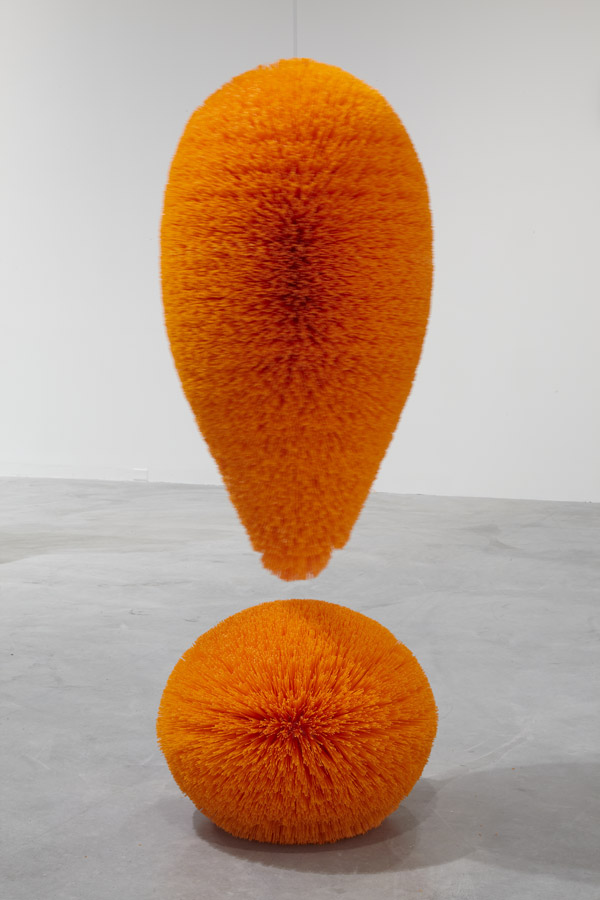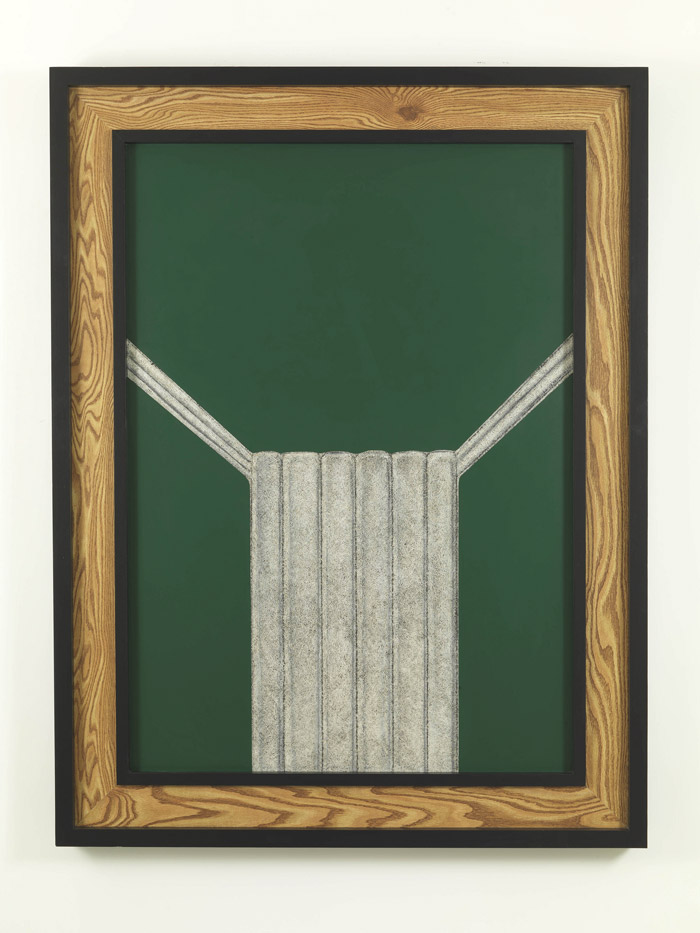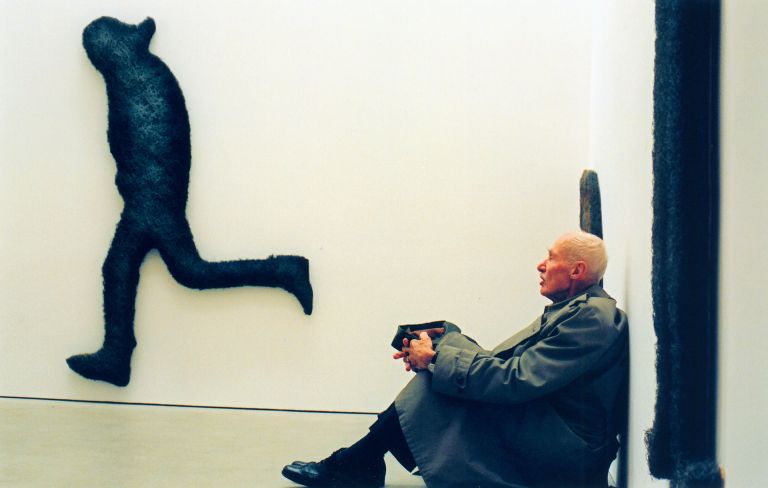Dates: 29 February – 10 May, 2020
Curators: Germano Celant and Manuel Cirauqui, curator of the Guggenheim Museum BilbaoMuseo Guggenheim Bilbao
Avenida Abandoibarra, 2
48009 Bilbao
https://www.guggenheim-bilbao.eus/en
contacto(at)guggenheim-bilbao.eus
informacion(at)guggenheim-bilbao.eus
Telephon
+34 944 35 90 00
+34 944 35 90 80Halfway between painting and sculpture, Artschwager develops a unique language using the new domestic materials of his time, always working toward the fusion of figuration and abstraction, artistic innovation and design, and ironically seeks to combine the functional and the useless.
Designed as an open labyrinth, the exhibition features a comprehensive selection of paintings and sculptures dating from the early 1960s to the first decade of this century.
Artschwager represents places, scenes from everyday life, and common objects such as tables, chairs, and dressers, interpreting them in ordinary, standardized industrial materials such as Formica, Celotex, acrylic paint, and rubberized horsehair.
Artschwager’s work continually questions appearance and essence, offering us a delicate and realistic, humorous yet monumental interpretation of the world.
Richard Artschwager Door } , 1983-84
Acrylic on wood, glass 207.6 x 165.1 x 24.8 cm
Collection Kerstin Hiller and Helmut Schmelzer,
on loan to Neues Museum Nürnberg
© Estate of Richard Artschwager, VEGAP, Bilbao, 2020
Photo: Annette Kradisch
| The Guggenheim Museum Bilbao presents the exhibition Richard Artschwager , a unique occasion to survey the creative career of Richard Artschwager (Washington, D.C., 1923 – Albany, New York, 2013), an artist who worked halfway between painting and sculpture and who developed a unique language using the new domestic materials of his time. This ambitious project, conceived by world-renowned curator Germano Celant and co-organized by the Guggenheim Museum Bilbao and MART – Museo di Arte Moderna e Contemporanea di Trento e Rovereto, comprises almost 70 pieces alongside a selection of rarely-seen archival documentation. |
 |
| Richard Artschwager Exclamation Point , 2010 Plastic bristles on a mahogany core painted with latex 165.1 × 55.9 × 55.9 cm Private collection Courtesy Gallery Xavier Hufkens, Brussels Photo: Allan Bovenberg © Estate of Richard Artschwager, VEGAP, Bilbao, 2020 |
| Designed as an open labyrinth highlighting the main nuclei of Artschwager’s oeuvre, the exhibition features a comprehensive selection of paintings and sculptures dating from the early 1960s to the first decade of the 21st century: from his first wood and Formica structures and paintings on Celotex to his nylon-bristle sculptures and “corner pieces,” including works in horsehair and so-called blps , which the artist began making in 1968 and displaying individually or on a citywide scale. Artschwager, who had a crucial experience as a cabinetmaker at the beginning of his career, always worked toward the fusion of figuration and abstraction, artistic innovation and design, and ironically sought to combine the functional and the useless. |
 |
| Richard Artschwager Weave (Green), 1991 Acrylic and Celotex on panel 171,2 x 131 x 9 cm Courtesy Galleria Alfonso Artiaco, Napoli Photo: Luciano Romano © Estate of Richard Artschwager, VEGAP, Bilbao, 2020 |
| With the paintings and sculptures of a long and varied career, Artschwager plots a distinctive course between handcraft and industrialization, encompassing space as well as the objects and beings that inhabit it. He represented places, scenes from everyday life, and common objects such as tables, chairs, and dressers, interpreting them in ordinary, standardized industrial materials such as Formica, Celotex, acrylic paint, and rubberized horsehair. He also explored pure geometric form, particularly in his sculptures, venturing into abstraction and solid figures evoking a sense of pictorial illusionism. |
 |
| Richard Artschwager Portrait Zero, 1961 Wood, screws, and rope 114,9 x 68,7 x 14 cm Sammlung Michalke, Germany © Estate of Richard Artschwager, VEGAP, Bilbao, 2020 |
|
Stylistically, Artschwager purposely maintained a characteristic ambivalence, challenging the iconographic dogmatism of tendencies (like Pop Art and Minimal Art) that claimed to be antithetical. Rather than allowing any conflict between schools, he practiced a synthesis that included all the elements, however different, and held them together. “What interests me, he declared, is above all the line of demarcation between ordinary things and the ones we recognize as objects of art.” Artschwager’s work continually questions appearance and essence, venturing into the realms of ontology, epistemology, and aesthetics with wit and intelligence. It offers us a delicate and realistic, humorous yet monumental interpretation of the world. |
About the artist |
 |
| Foto: Richard Artschwager in his exhibition Gegenwärtig aber ungenau, Georg Kargl BOX, Vienna, 2005. |
|
Richard Artschwager was born in 1923 in Washington D.C., and died in 2013 in Albany, New York. After receiving a BA in 1948 from Cornell University, New York, he studied under Amédée Ozenfant, one of the pioneers of abstraction. In the early 1950s, Artschwager became involved in cabinetmaking, producing simple pieces of furniture. After a ruinous workshop fire at the end of the decade, he began making sculpture using leftover industrial materiales; then expanded into painting, drawing, site-specific installation, and photo-based work. Artschwager forged a unique path in art from the early 1950s through the early 21st century, making the visual comprehension of space and the everyday objects that occupy it strangely unfamiliar. In his work, both pictorial and sculptural, an Anonymous sheet of walnut-patterned Formica is both itself and a depiction of a wooden plane; a table or a chair is furniture, sculpture, and image all at once; and a painting or a sculpture can be a “multi-picture” or “three-dimensional still life”. Artschwager foregounded the structures or perception, striving to conflate the world of images—which can be aprehended but not physically grasped—and the world of objects, the same space that we ourselves occupy. Artschwager’s first exhibition took place at the Art Directions Gallery, New York, in 1959; and was followed by the first of many solo exhibitions with Leo Castelli in 1965. Solo exhibitions include Up and Across, |
DIDAKTIKA |
|
As part of the Didaktika project, sponsored by BBK, the public can find information on Richard Artschwager’s career and the context of his work from the early 1950s through the first decade of the 21st century in the ‘Did you know…?’ section of the exhibition page on the Museum’s website. In addition, the following activities have been organized in connection with the exhibition: Conversation with Germano Celant on Richard Artschwager (February 26) Germano Celant, curator of the exhibition and an international figure of contemporary art as a historian, theorist and exhibition curator, will talk with Manuel Cirauqui, curator of the Guggenheim Museum Bilbao, on the importance and uniqueness of this Richard Artschwager’s work. Shared Reflections Unique tours led by members of the Museum’s Curatorial and Education Departments, offering different • Curatorial View (March 11) Manuel Cirauqui, Curator of the Museum, will lead a visit through the main works of the exhibition. • Key Concepts (March 25) Luz Maguregui, Education Coordinator at the Museum, will engage visitors in a dialogue on the main aspects of Artschwager’s work. *Sponsored by Fundación Vizcaína Aguirre Screening of Shut up and Look (March 20) This documentary, directed by Maryte Kavaliauskas and produced together with Morning Slayter, looks at the many-faceted career of Richard Artschwager through his own words, often humorous, to reveal his unique creative philosophy. |
|
Museo Guggenheim Bilbao HOURS From Tuesday through Sunday Monday closed, except: |




